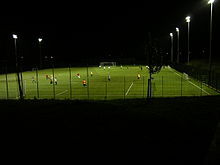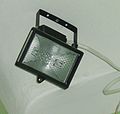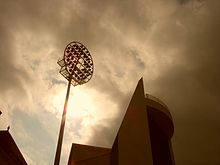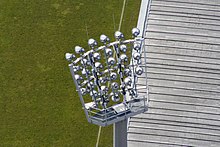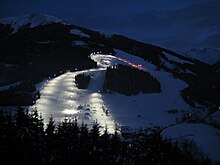
The Fartown Ground or just simply Fartown is a sports ground located in the Huddersfield suburb of Fartown in West Yorkshire, England and is predominantly famous for being the home ground of Huddersfield Rugby League Club from 1878 to 1992. The grounds consisted of a rugby ground, a cricket ground used by Yorkshire County Cricket Club, Bowling greens and a running track as well as a pavilion. It was the scene of many great games, including the Challenge Cup finals of 1908 and 1910, several Challenge Cup semi finals, John Player Cup finals and international matches.
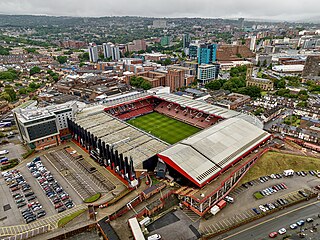
Bramall Lane is a football stadium in Sheffield, South Yorkshire, England, which is the home of Sheffield United.

Rugby Park, also known as The BBSP Stadium Rugby Park for sponsorship reasons, is a football stadium which is the home of Scottish Premiership club Kilmarnock F.C. and is situated in the Scottish town of Kilmarnock. With a capacity of 15,003, it is the 7th–largest football stadium in Scotland, and was first used in 1899, also having been used for concerts, rugby union and international football fixtures. The stadium underwent a major redevelopment in 1994–1995, becoming an all-seater stadium with a capacity of 18,128. In 2002, the club constructed the Park Hotel, a 4-star hotel complex next to the ground.
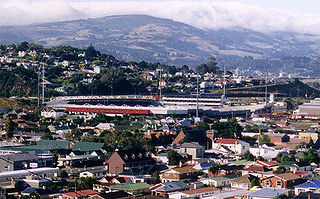
Carisbrook was a major sporting venue in Dunedin, New Zealand. The city's main domestic and international rugby union venue, it was also used for other sports such as cricket, football, rugby league and motocross. In 1922, Carisbrook hosted the first international football match between Australia and New Zealand. The hosts won 3-1.

The Bradford Bulls are a professional rugby league club in Bradford, West Yorkshire, England, and compete in the Championship, the second tier of British rugby league.

Murrayfield Stadium is a rugby union stadium located in the Murrayfield area of Edinburgh, Scotland. The stadium is owned by the Scottish Rugby Union (SRU) who has its headquarters based at the stadium, and is the national stadium of the Scotland national rugby union team. With a seating capacity of 67,144, it is the largest stadium in Scotland, the fifth largest in the United Kingdom, and the twenty–second largest in Europe.

Carrara Stadium is a stadium on the Gold Coast in Queensland, Australia, located in the suburb of Carrara.
A night game, also called a nighter, is a sporting event that takes place, completely or partially, after the local sunset. Depending on the sport, this can be done either with floodlights or with the usual low-light conditions. The term "night game" is typically used only in reference to sports traditionally held outdoors. Although indoor sporting events often take place after local sunset, these events are artificially lighted regardless of the time of day they take place.

Headingley Stadium is a stadium complex in Headingley, Leeds, West Yorkshire, England. Linked by a two-sided stand housing common facilities, it comprises the two following separate grounds: Headingley Cricket Ground and Headingley Rugby Stadium.

The City Ground is a football stadium in West Bridgford, Nottinghamshire, England, on the banks of the River Trent. It has been home to Nottingham Forest F.C. since 1898 and has a capacity of 30,455.

Turf Moor is an association football stadium in Burnley, Lancashire, England, which has been the home of Burnley Football Club since 1883. This unbroken service makes Turf Moor the second-longest continuously used ground in English professional football. The stadium is situated on Harry Potts Way, named after the manager who won the 1959–60 First Division with the club, and has a capacity of 21,944.

Odsal Stadium in Bradford, West Yorkshire, England, is a multi-purpose stadium currently the home of Bradford Bulls Rugby League team and Yorstox Stock Cars who host regular monthly meetings of BriSCA F1 Stock Cars and BriSCA F2 Stock Cars. It has also been used by the Bradford Dukes speedway team, hosting the 1997 Speedway Grand Prix of Great Britain. The football team Bradford City used Odsal as a temporary groundshare following the Valley Parade fire while their ground was rebuilt. Odsal Stadium has also historically hosted baseball, women's football, American football, basketball, kabbadi, show jumping, tennis, live music concerts, and international Rugby League matches over the years.

The Pilot Field is a football stadium in Hastings, East Sussex. It is home to Hastings United men's and women's teams. The men's team currently play in the Isthmian League premier division, and the women's team currently play in the LSERFL division one south. The club have used the ground since 1985 after the old Hastings United folded, having previously used the ground between 1920 and 1948. The current capacity stands at 4,050 although over 9,000 have been known to attend events in the past and the closure of the grass bank has decreased the capacity.
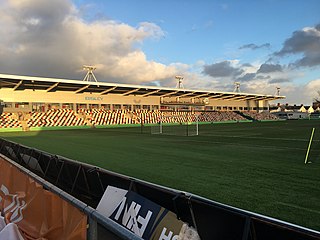
Rodney Parade is a stadium in the city of Newport, South Wales. It is located on the east bank of the River Usk in Newport city centre. The ground is on Rodney Road, a short walk from the city's central bus and railway stations via Newport Bridge or Newport City footbridge. There is no spectator car park at the ground but a number of multi-storey car parks are nearby.

The Vetch Field was a football stadium in Swansea, Wales. It was used for football matches and was the home ground of Swansea City until the club moved to the newly built Liberty Stadium in 2005. Opened in 1912, the ground held around 12,000 at the time of its closure, but upwards of 30,000 at its peak.

Springfield Park was a multi-purpose stadium in Wigan, Greater Manchester. It was the home ground of Wigan Athletic F.C. until the club moved to the new JJB Stadium after the 1998–99 season. At its largest, the stadium held 40,000. In its 102-year existence the ground only saw 32 years as a Football League venue, 11 years for Wigan Borough F.C. and 21 years for Wigan Athletic FC, before it was demolished to make way for a housing estate in 1999.
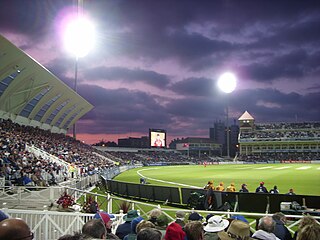
Floodlit (day/night) Cricket is cricket played under floodlights at night. The use of floodlights in cricket matches has helped to bring much investment into the game both at a national and an international level since it began in 1977. Today floodlit (day/night) cricket is played in most of the test playing nations although some nations only started hosting day/night matches in the last 10 to 14 years.

Day/night cricket, also known as floodlit cricket, is a cricket match that is played either totally or partially under floodlights in the evening. The first regular cricket to be played under floodlights occurred during World Series Cricket, unsanctioned by the International Cricket Council (ICC), attracting large crowds to see some of the world's best players compete in Australia and the West Indies. In 1979, when the ICC and World Series Cricket came to an understanding, the first floodlit One Day International was played, also in Australia. Floodlit cricket has since been played around the world, although England was slow to take it up due to their climate. Floodlit first-class cricket was first played in 1994, when the concept was tried during the Sheffield Shield. Day/night cricket is now commonplace in one-day cricket and Twenty20 cricket. For instance, all 27 matches in the 2014 ICC World Twenty20 were day/night matches, as were most matches in the 2011 Cricket World Cup.
Cathkin Park was a football ground in the Crosshill area of Glasgow, Scotland. It was the home ground of Third Lanark from their foundation in 1872 until they moved to New Cathkin Park in 1903. It also hosted Scottish Cup final matches and the Scotland national team.
The Birmingham Club was an English association football club based at the cricket pitch on the Aston Lower Grounds, and one of the first clubs in Birmingham.

